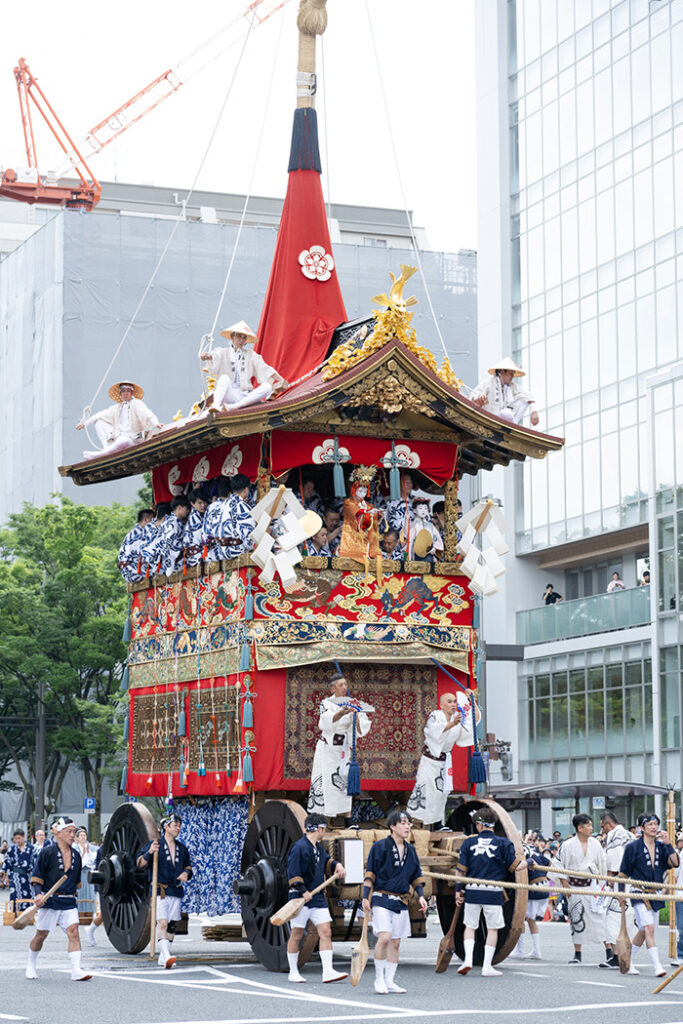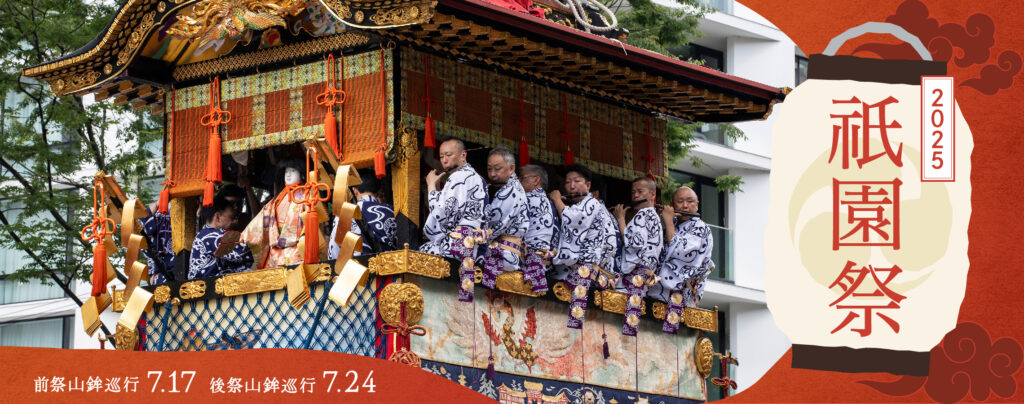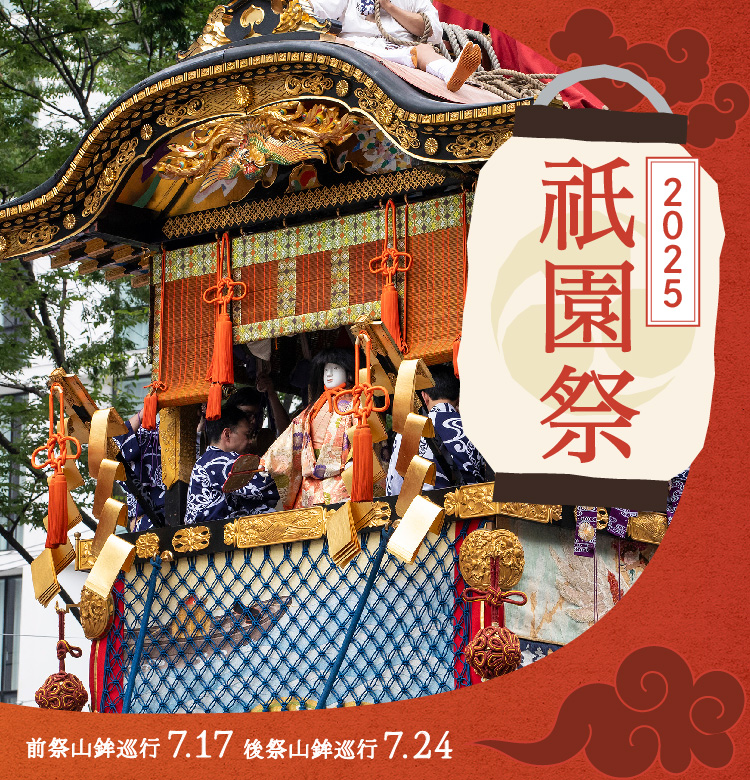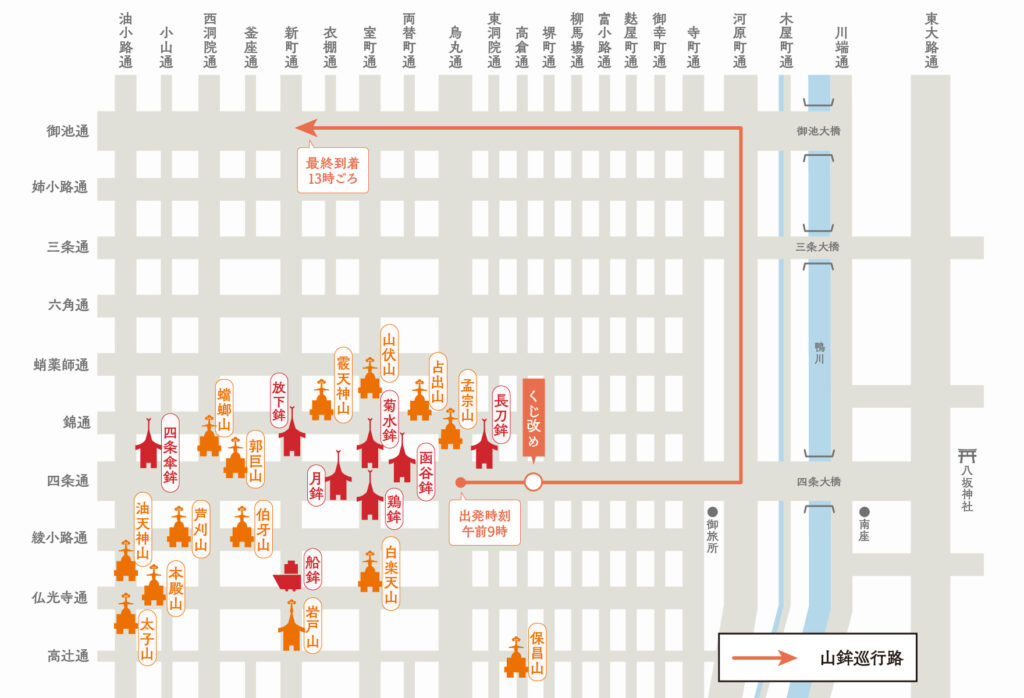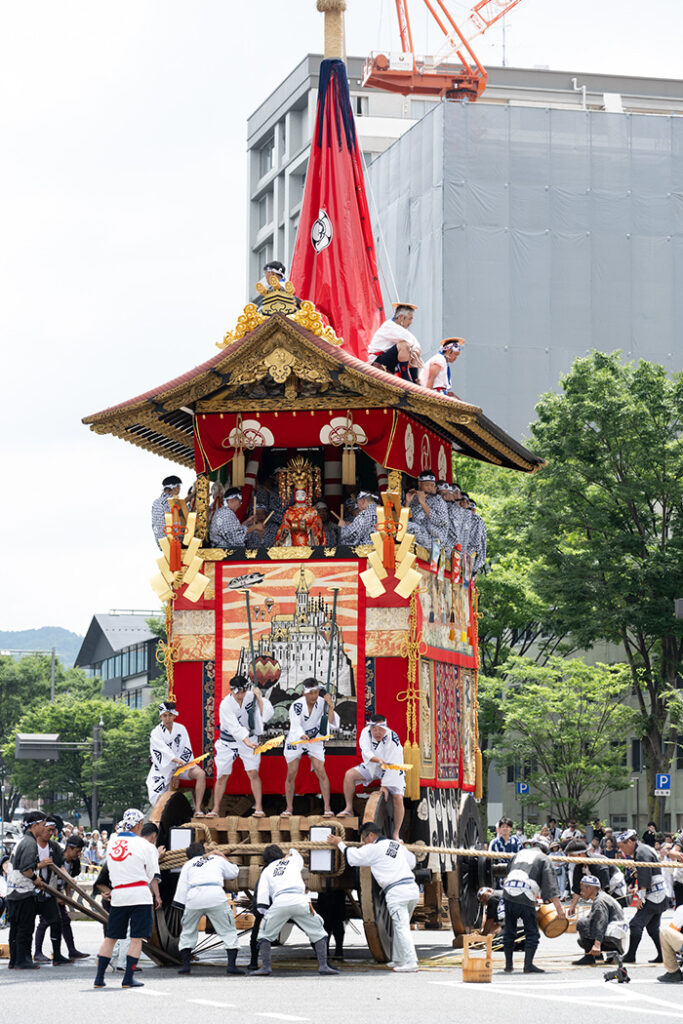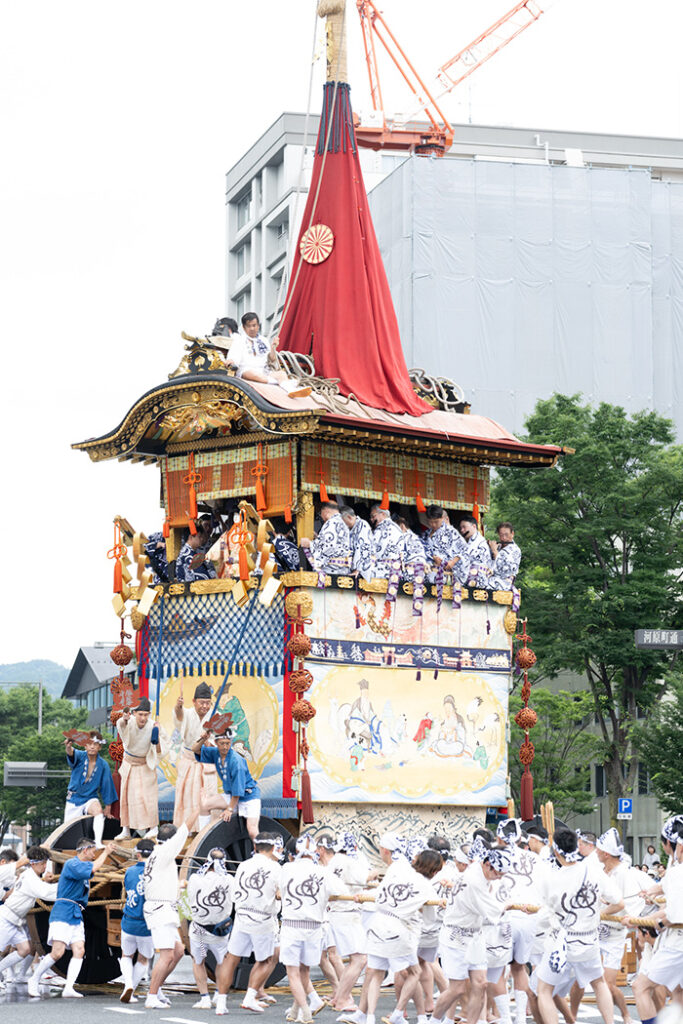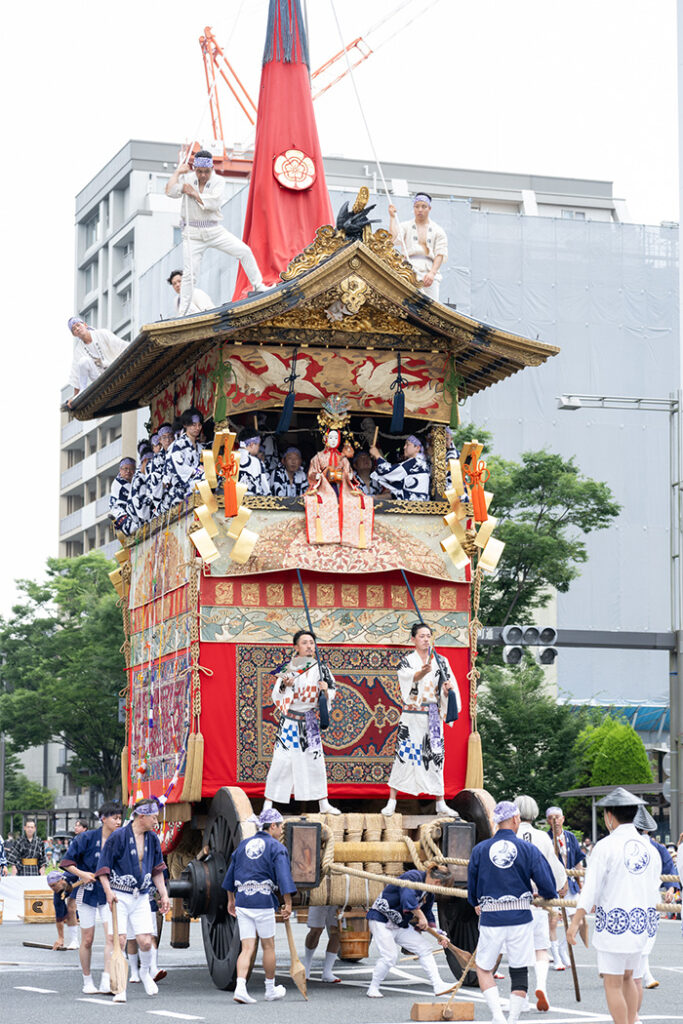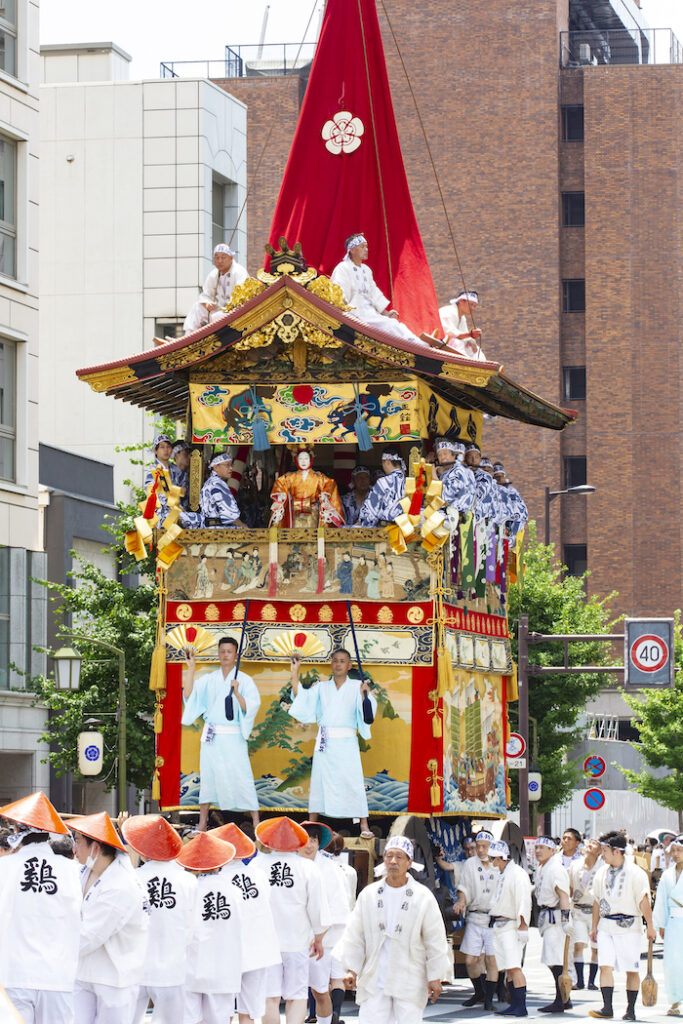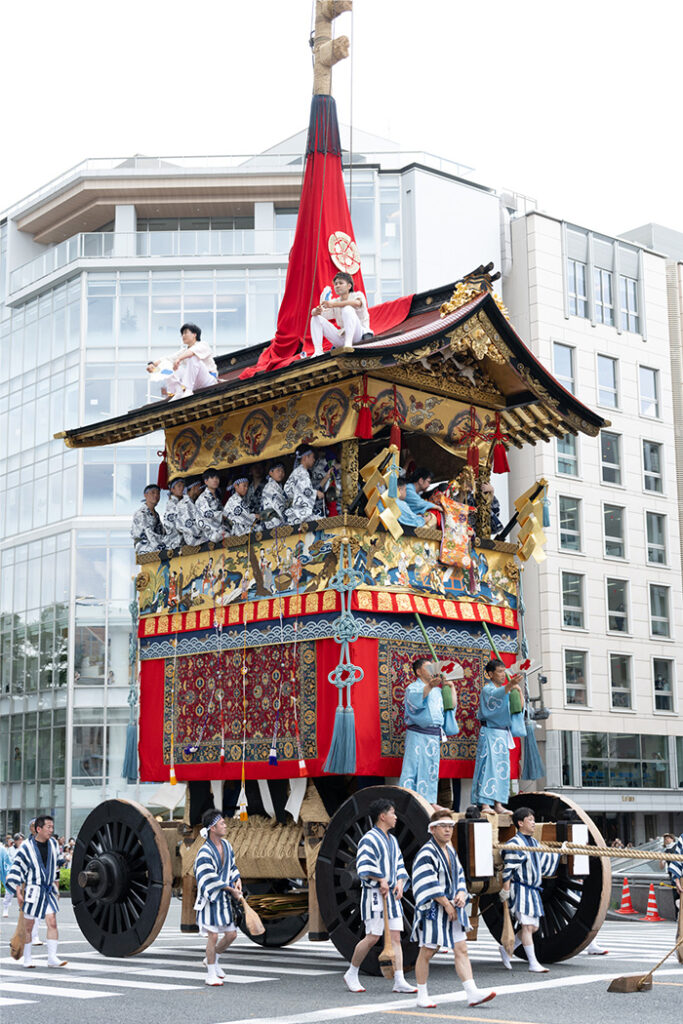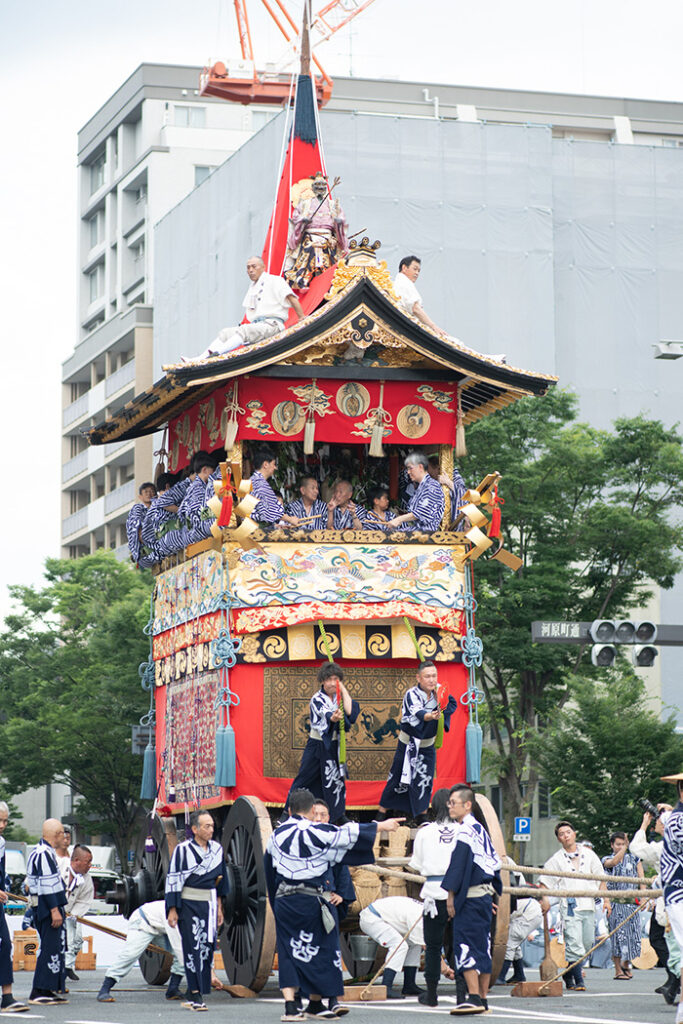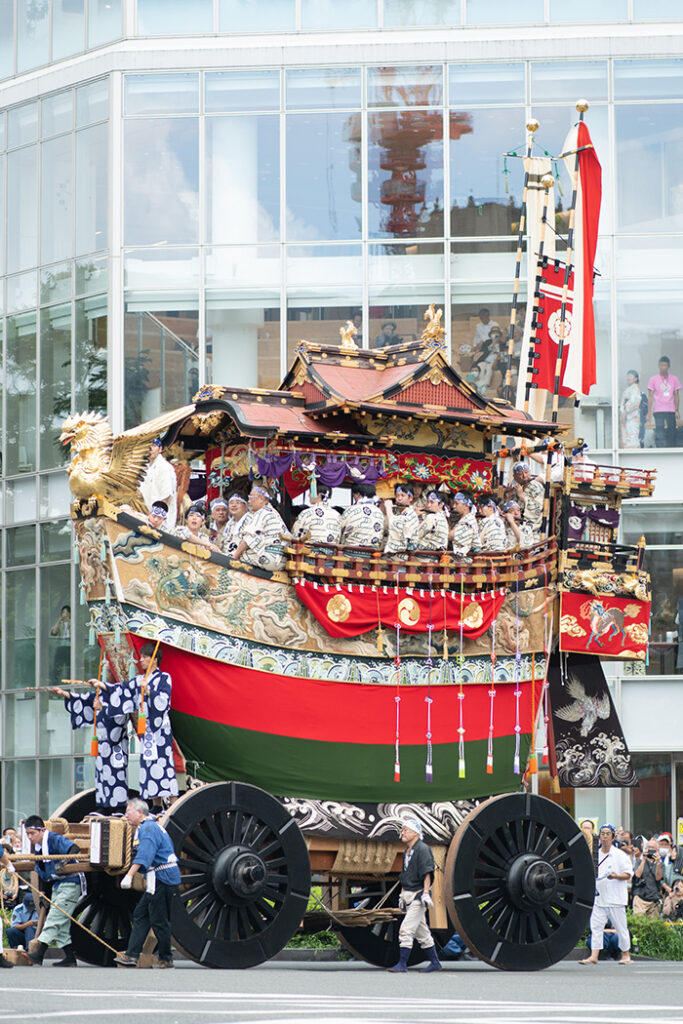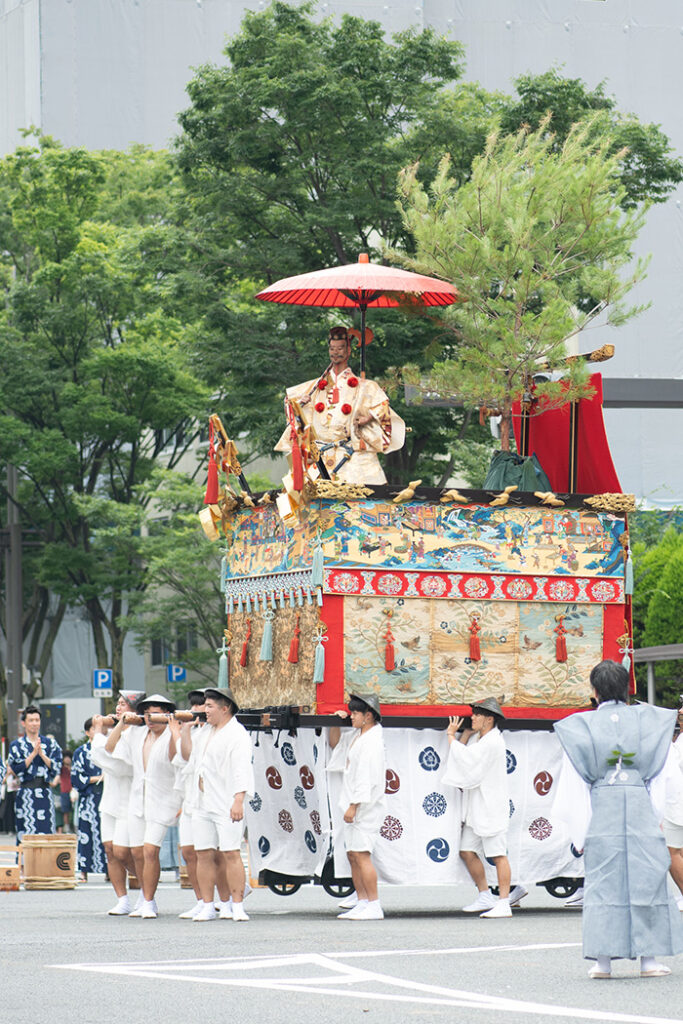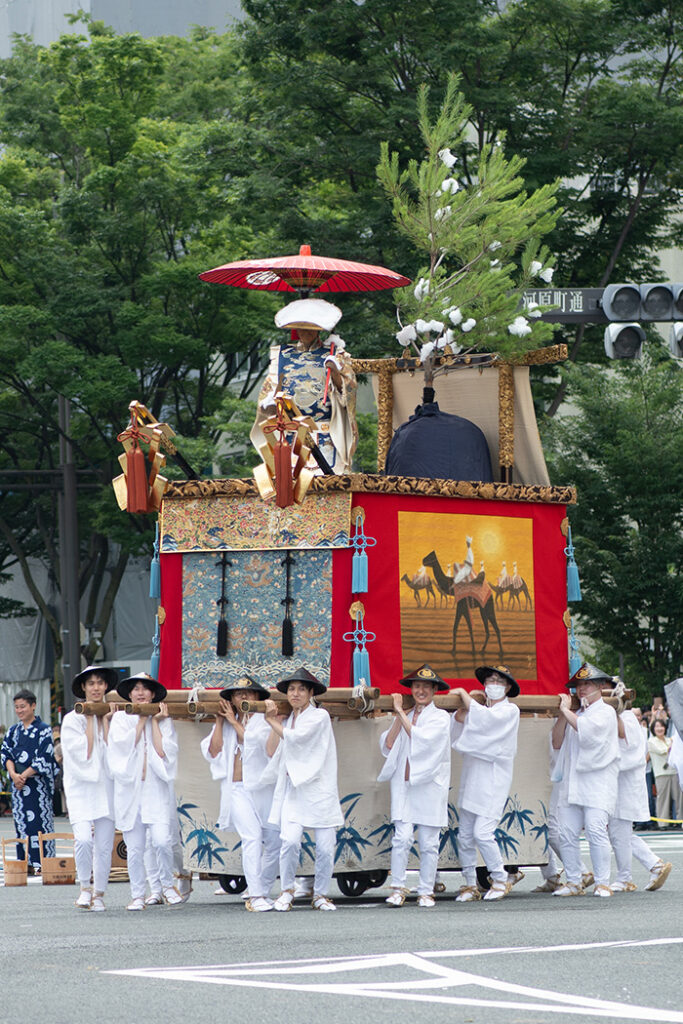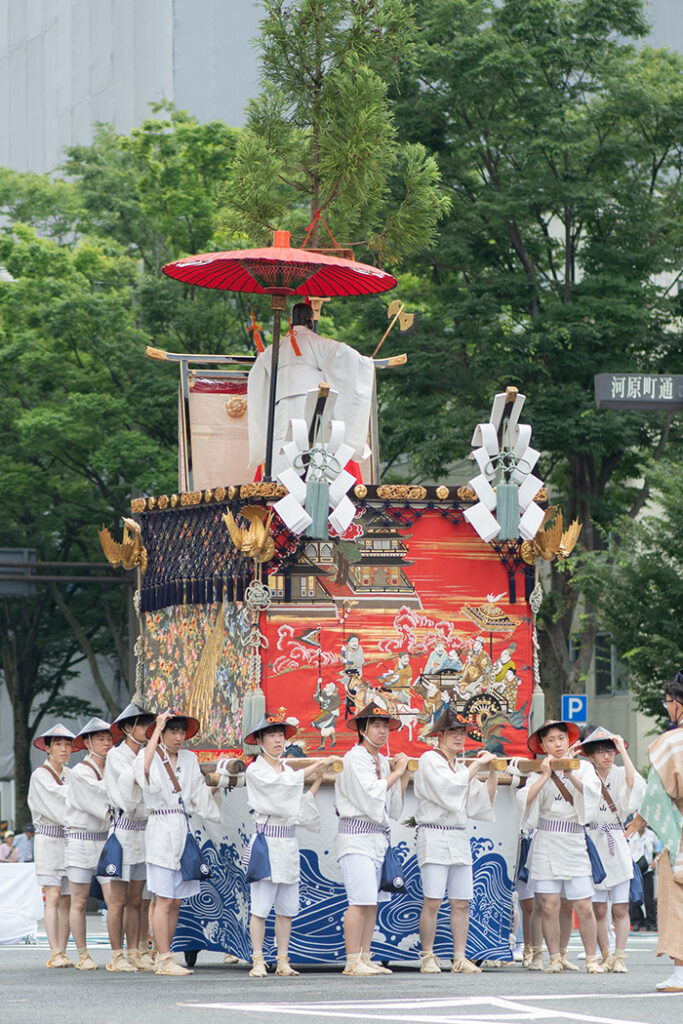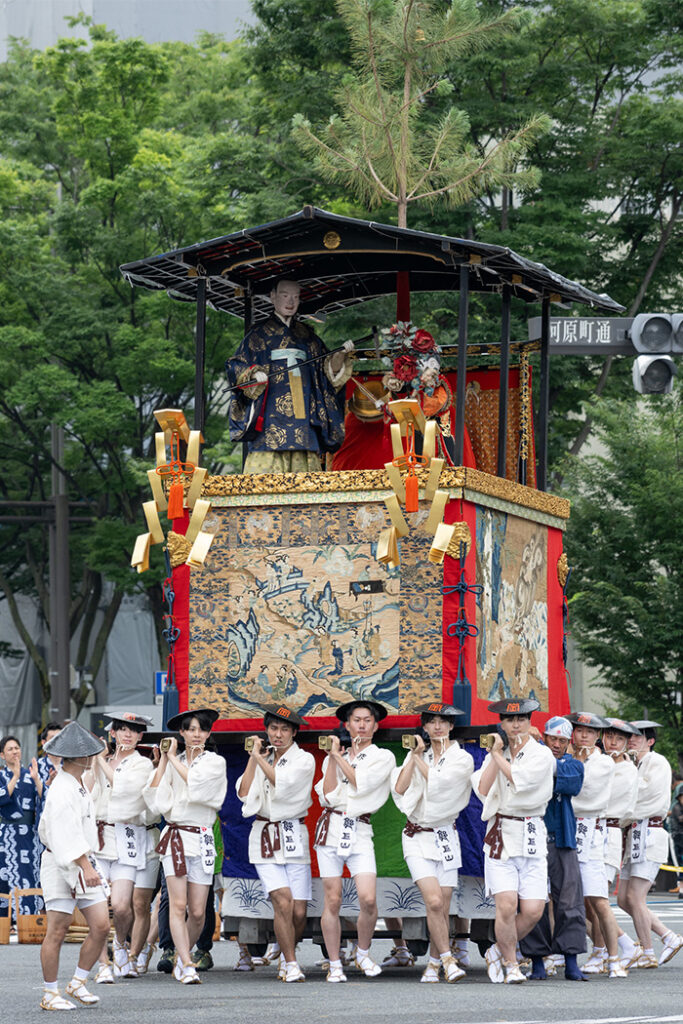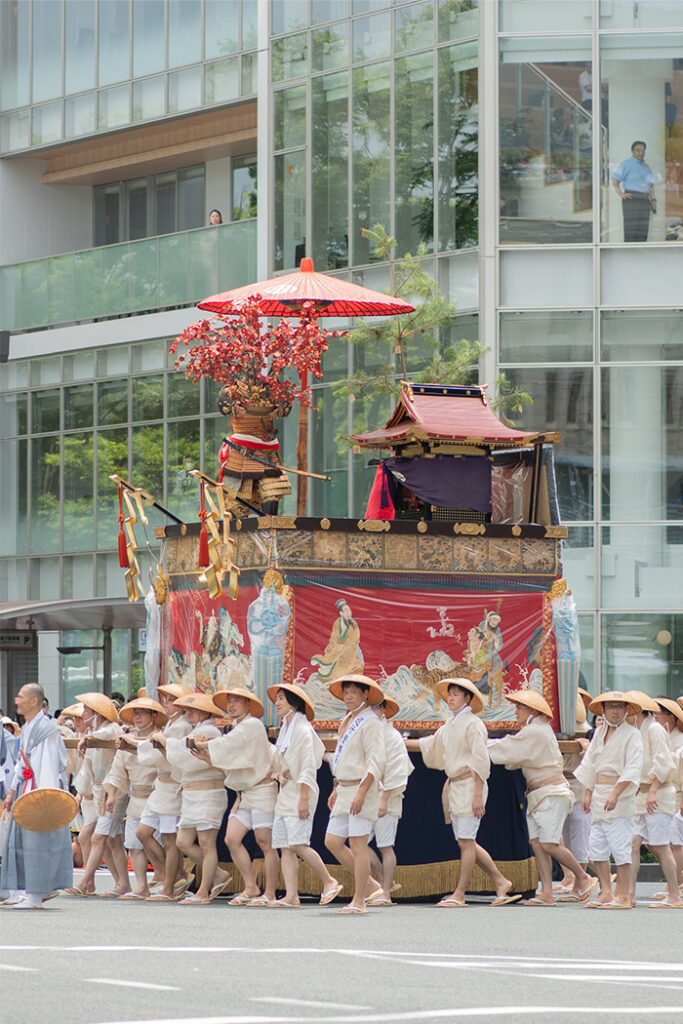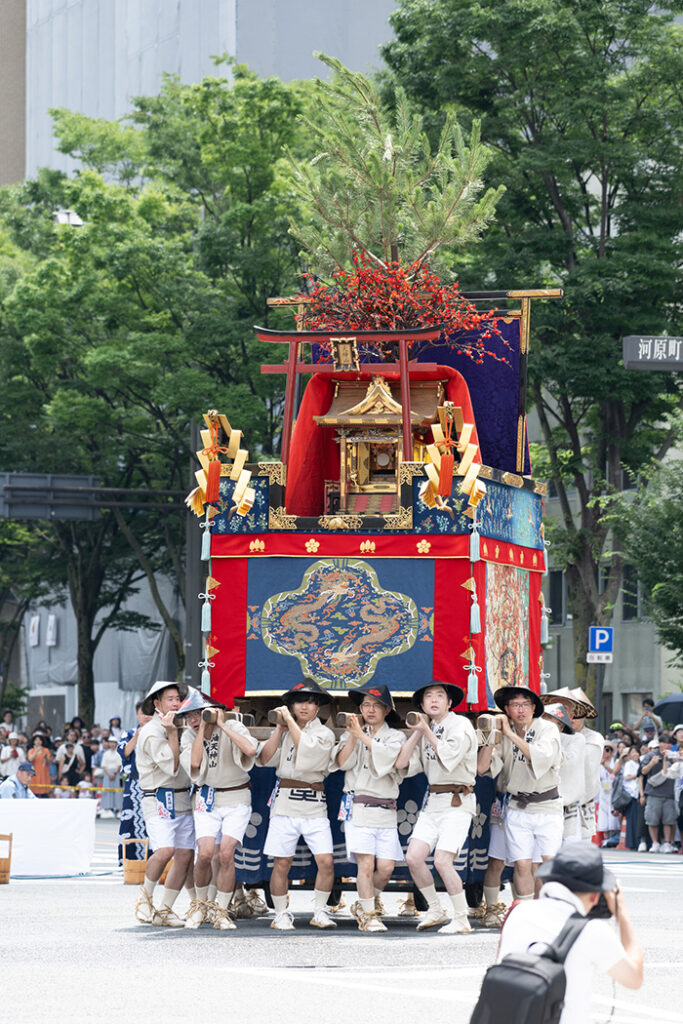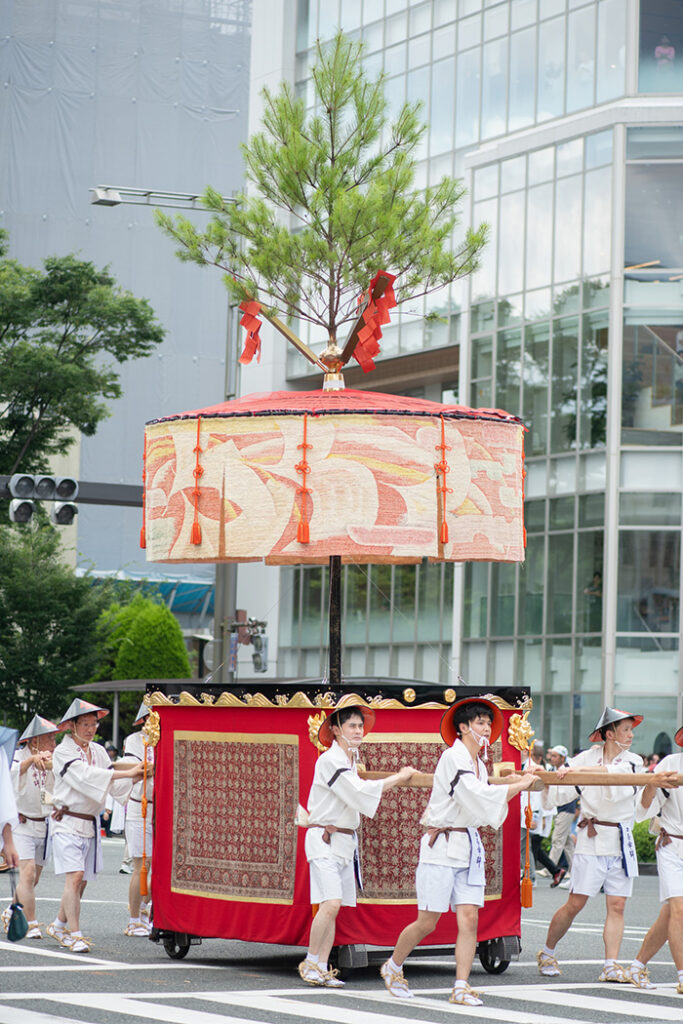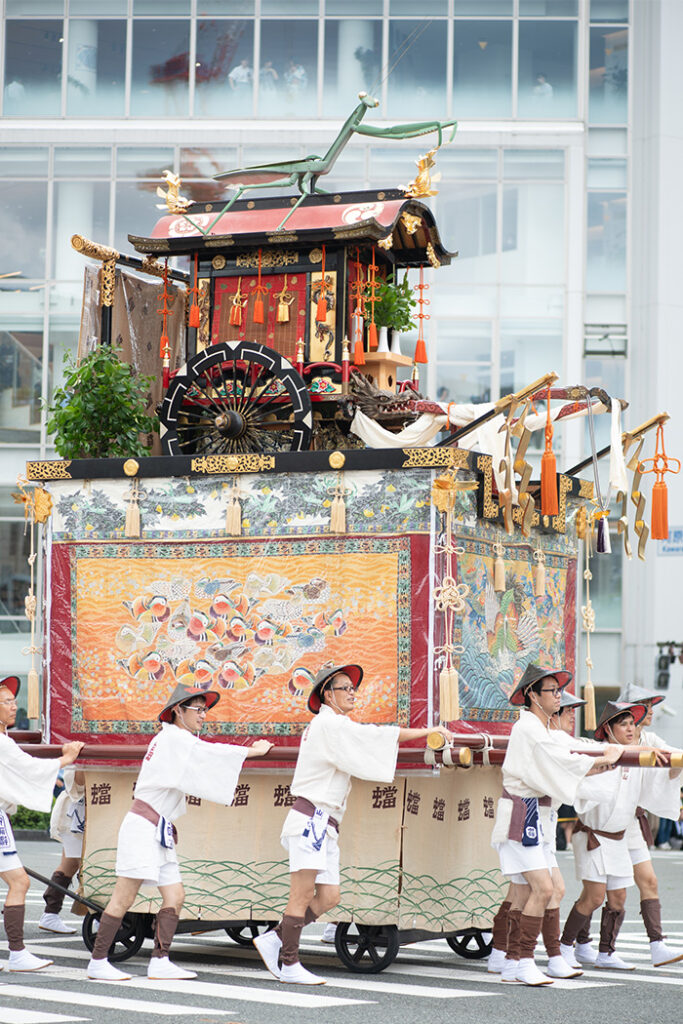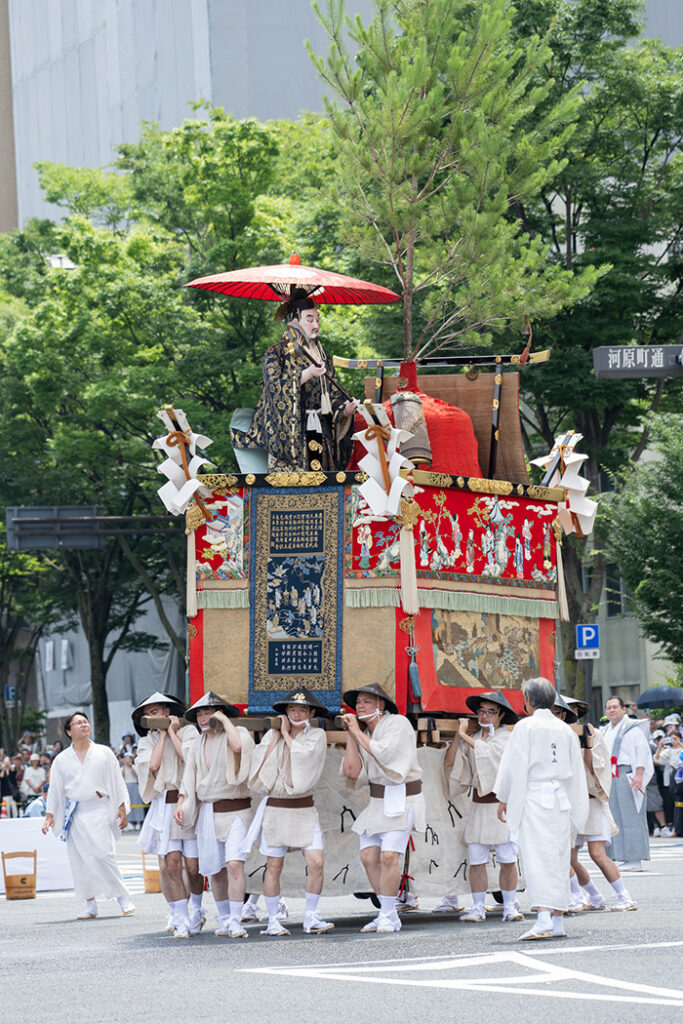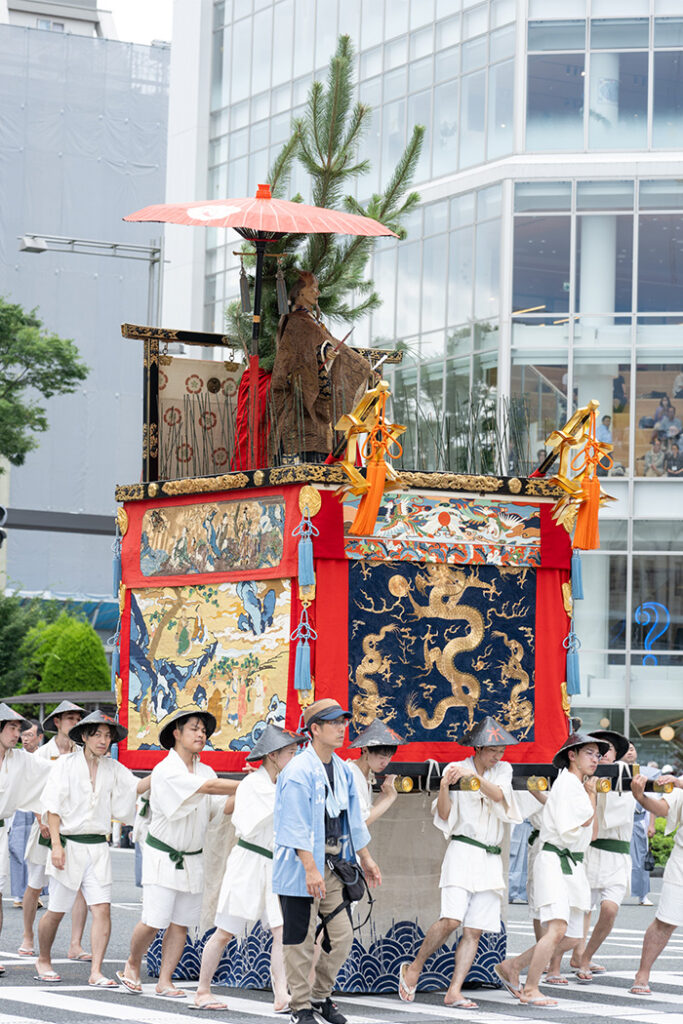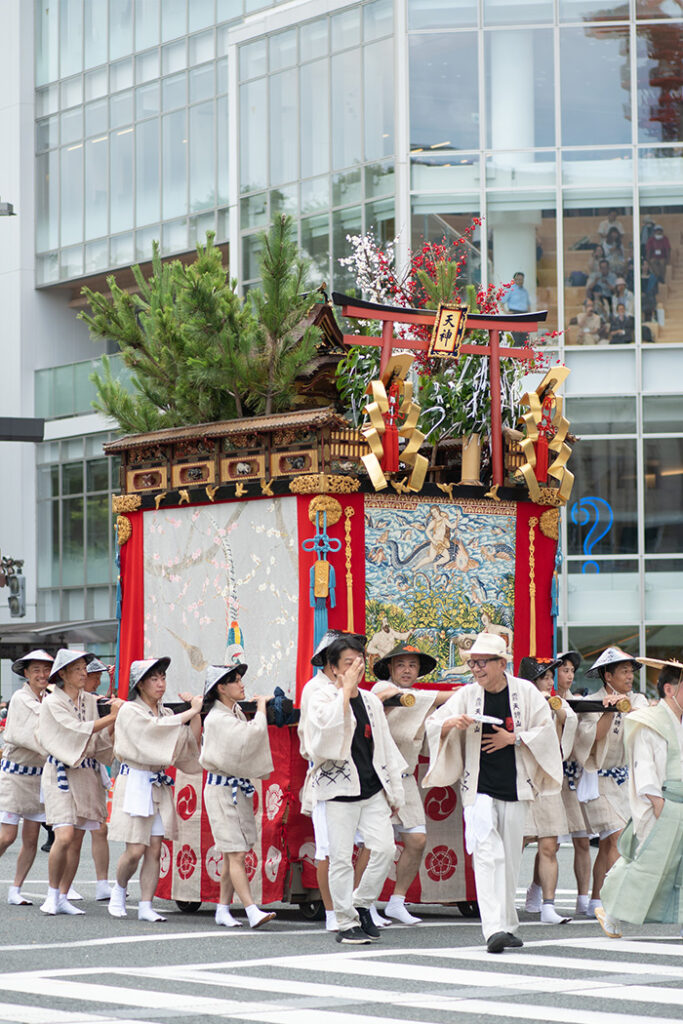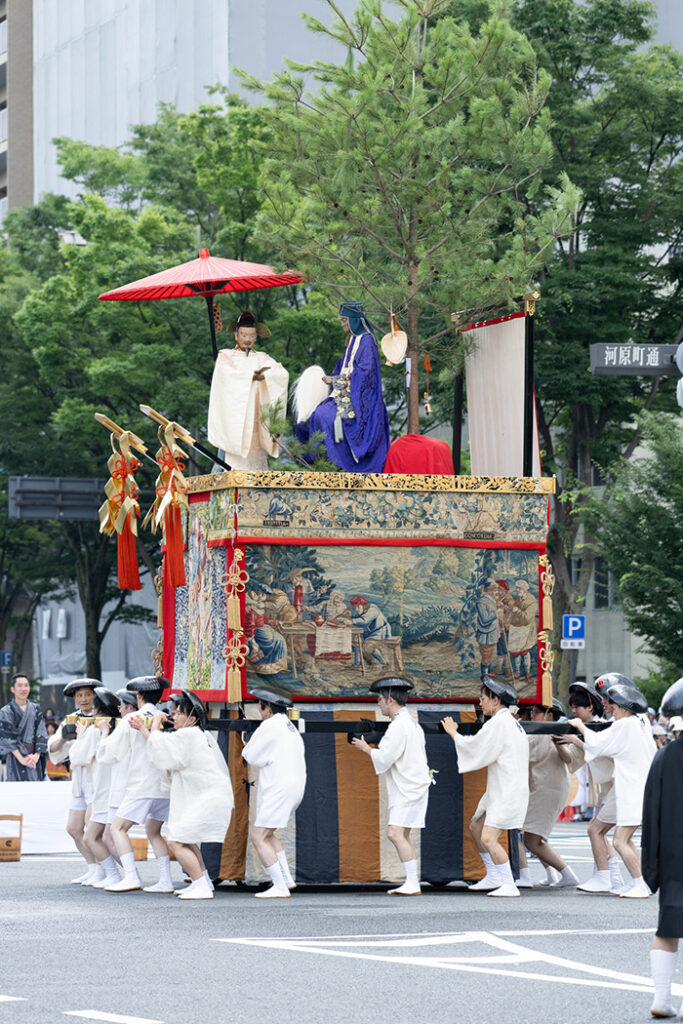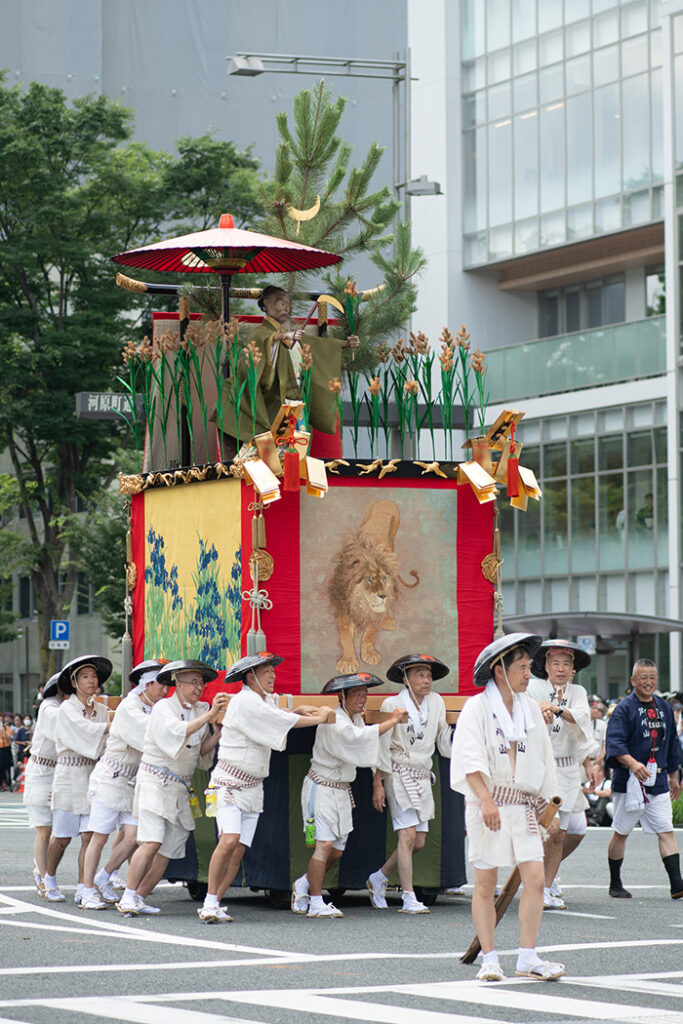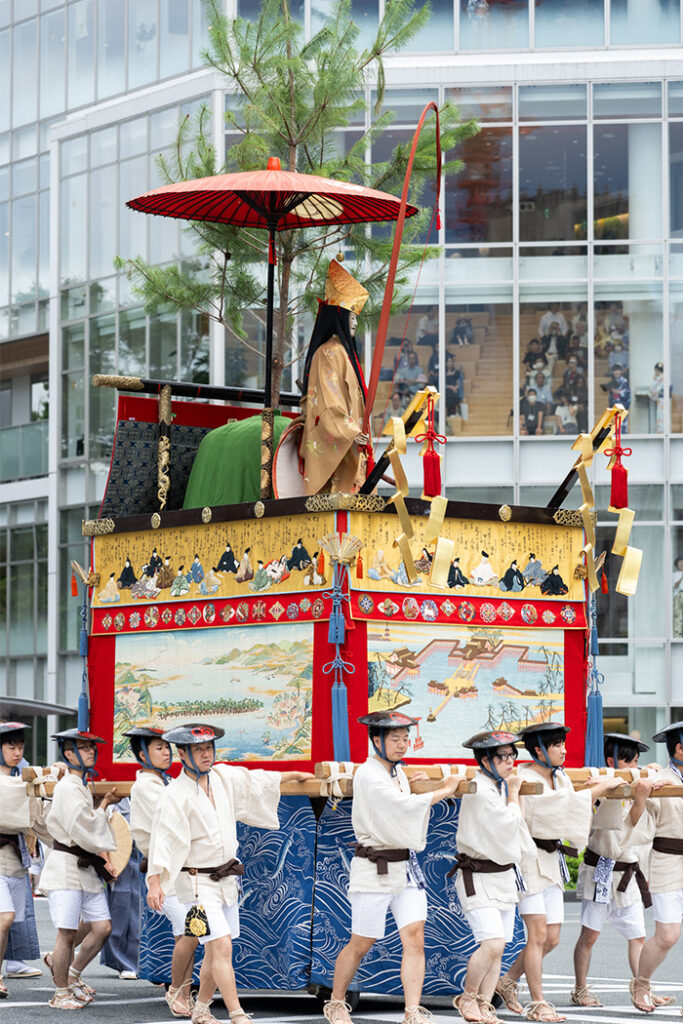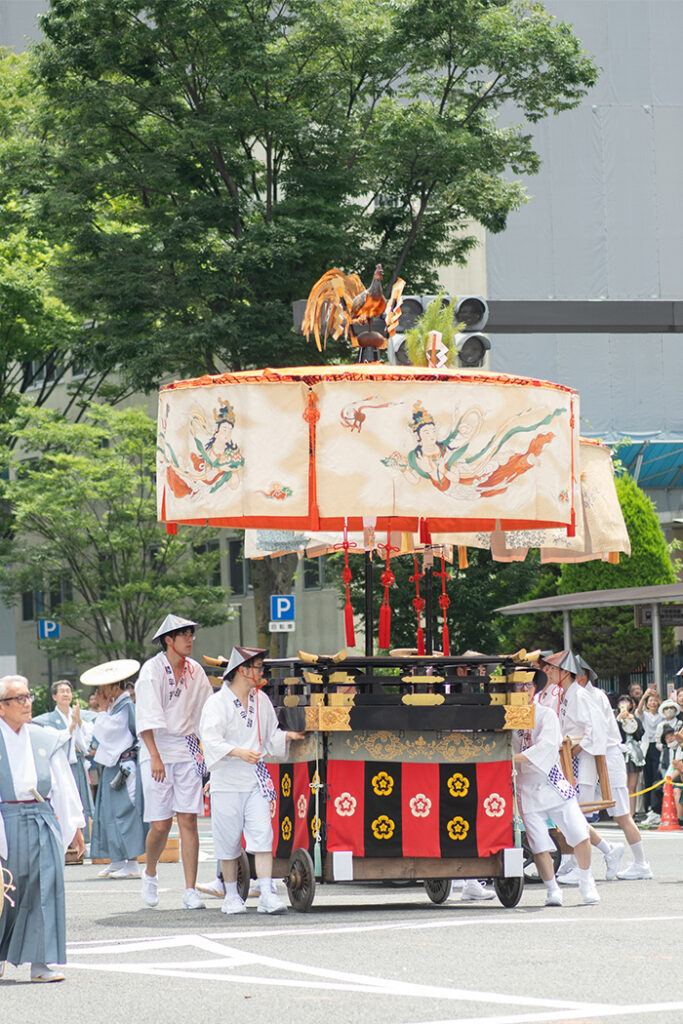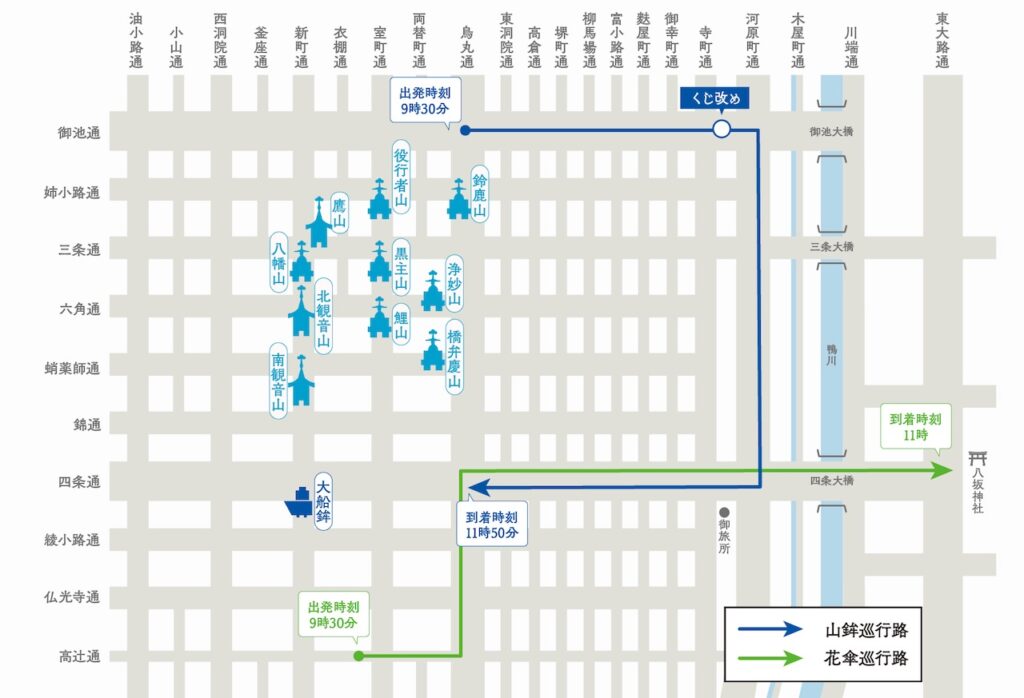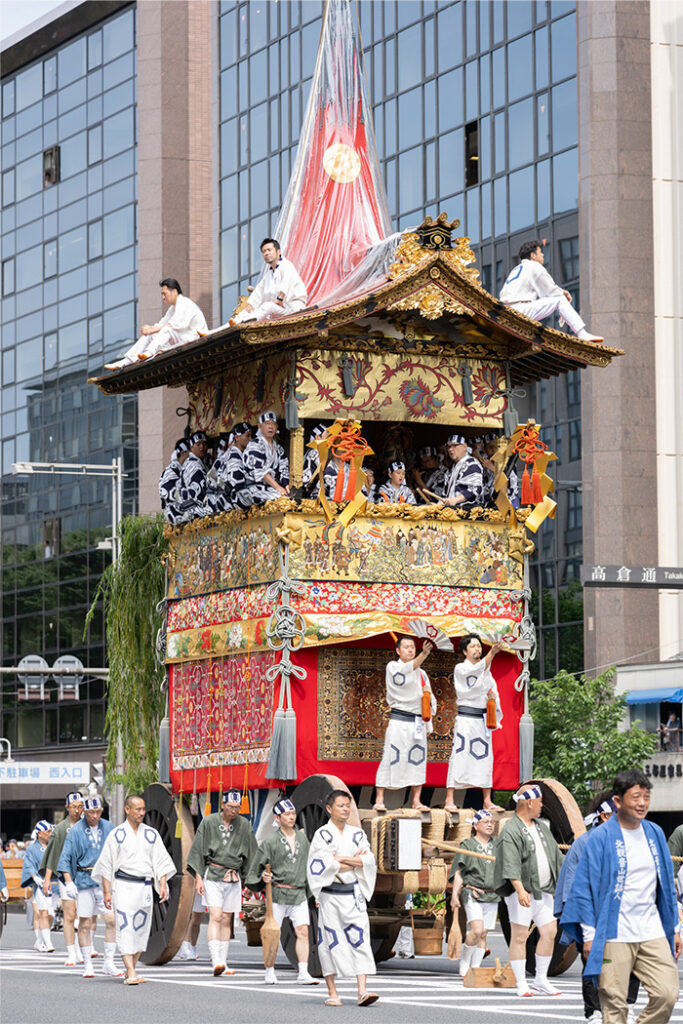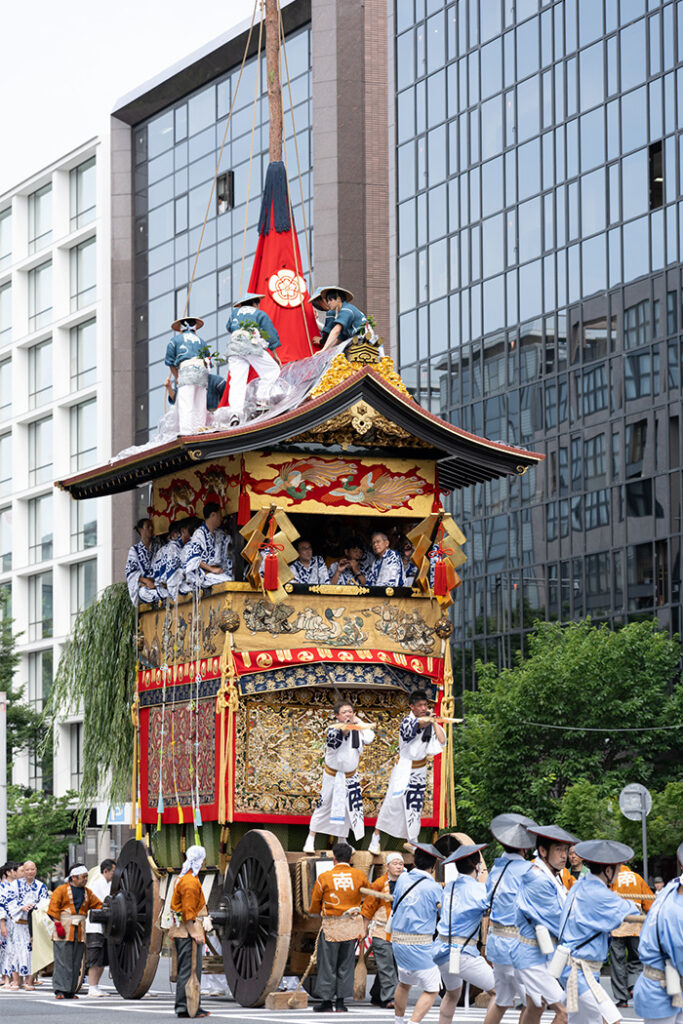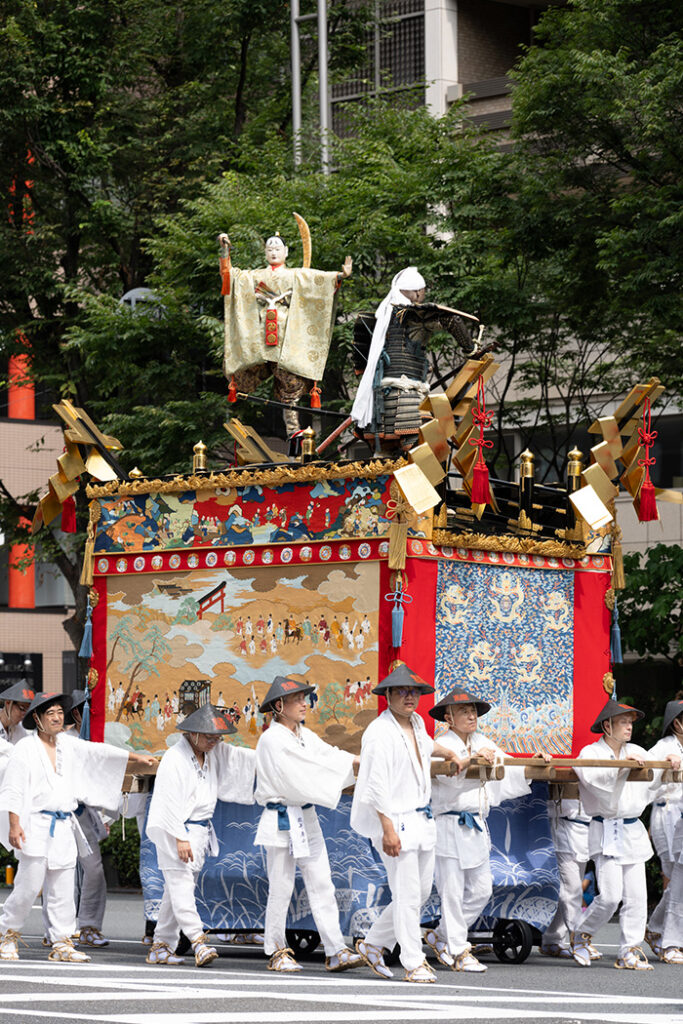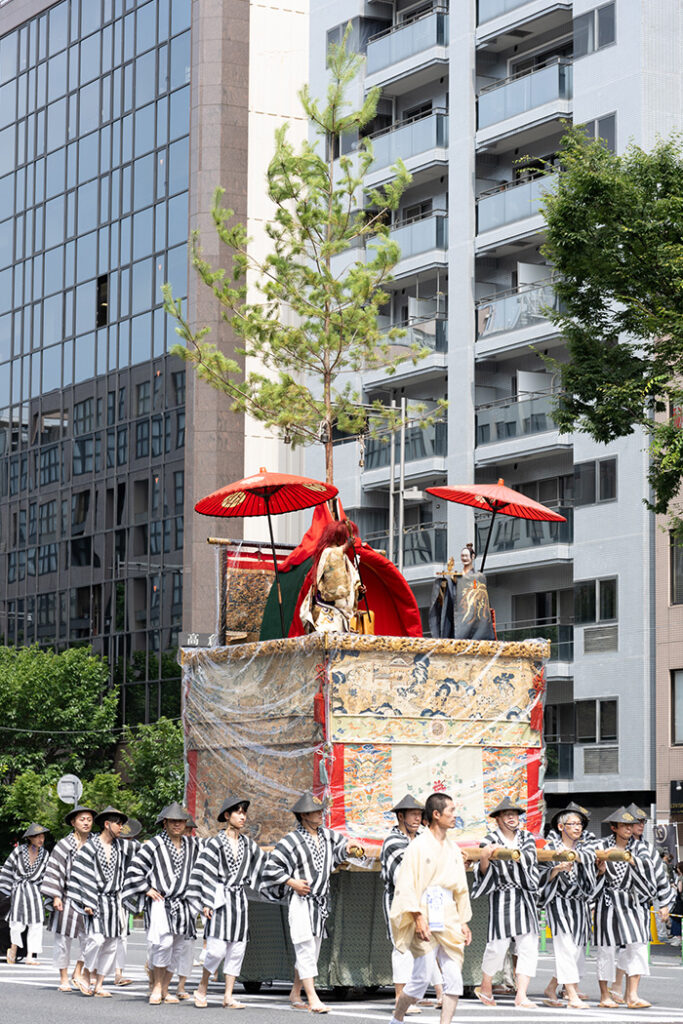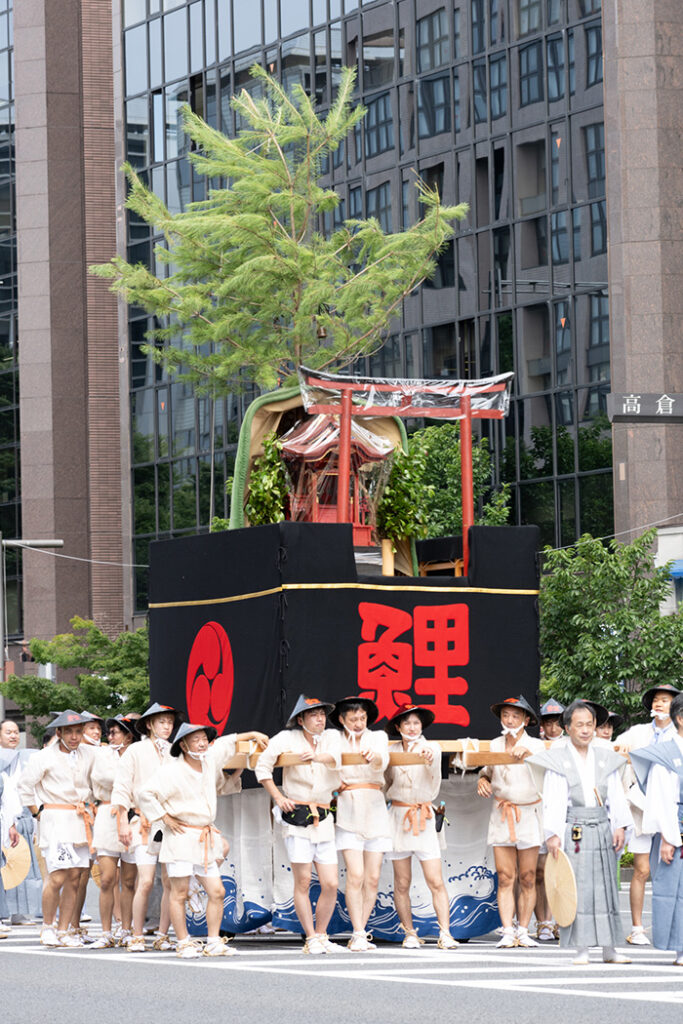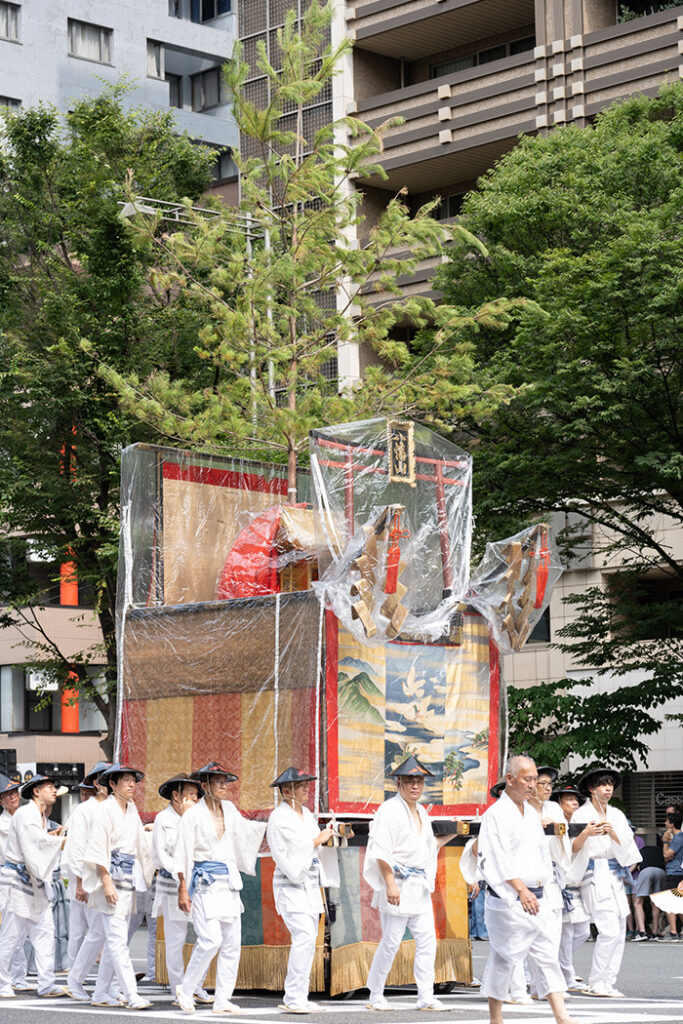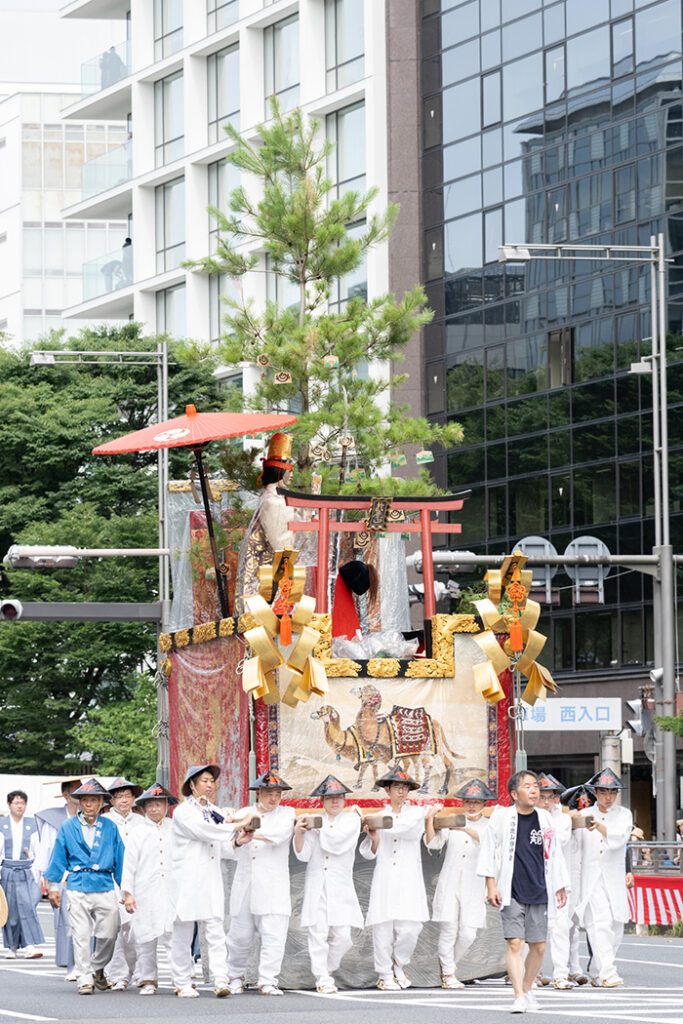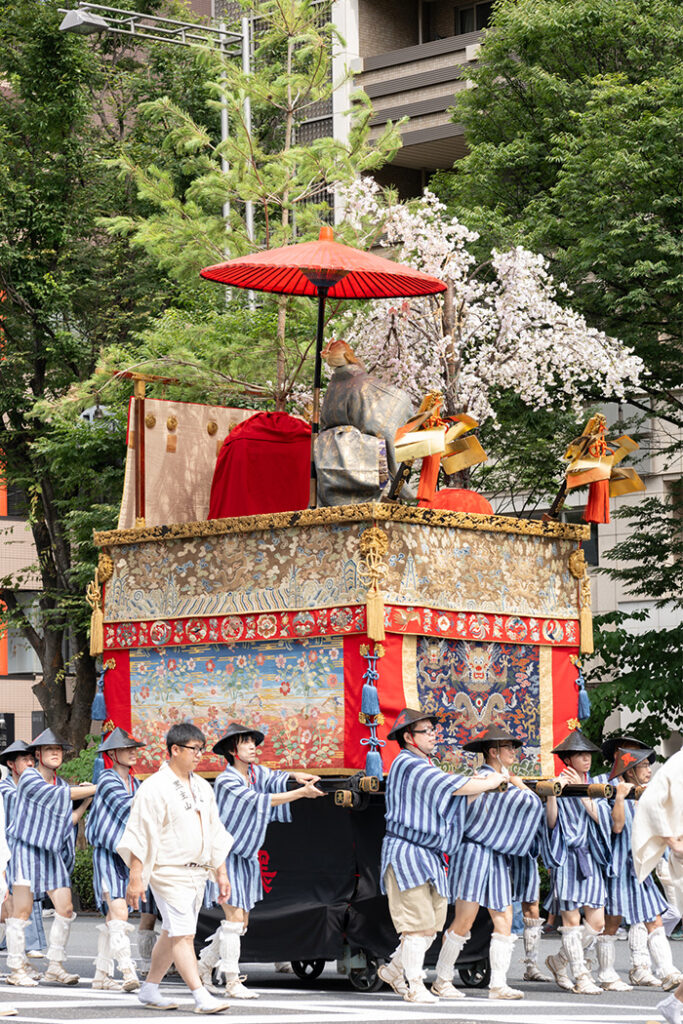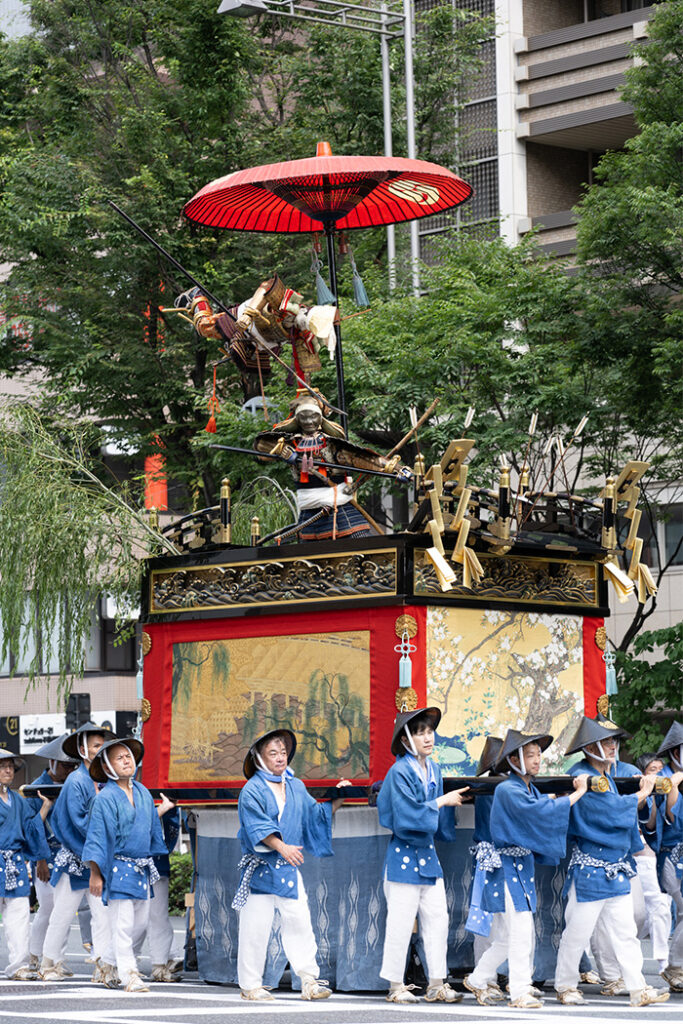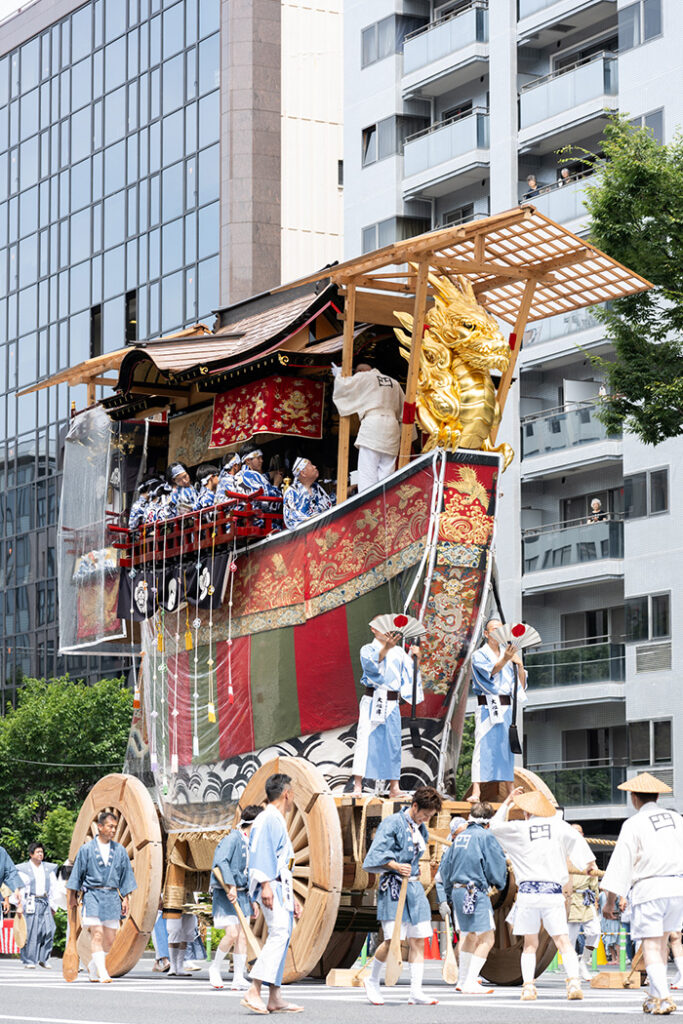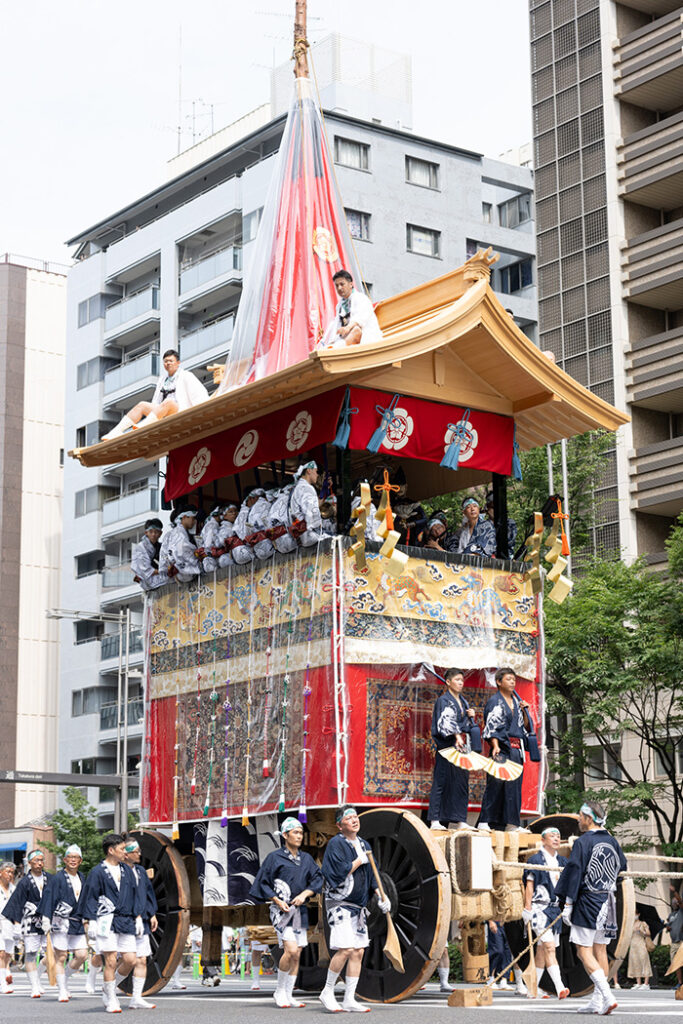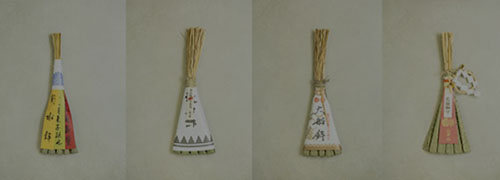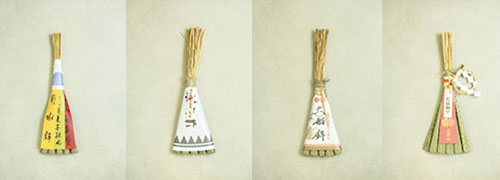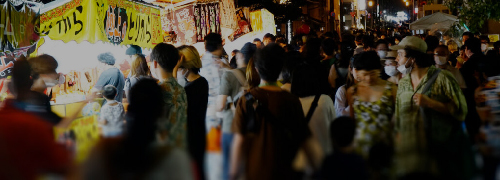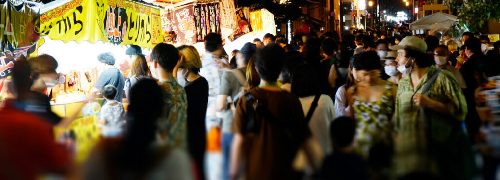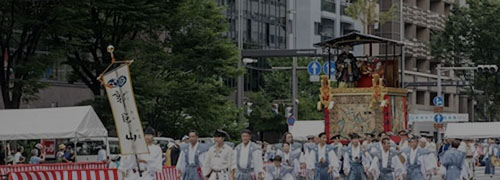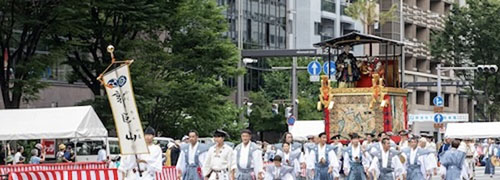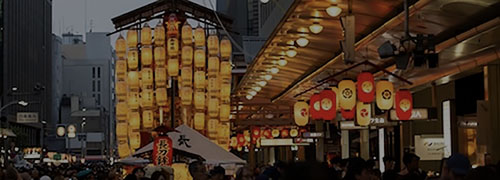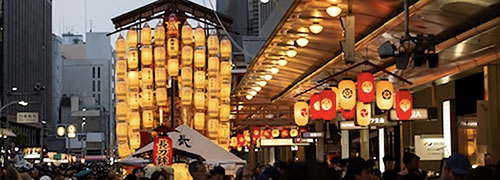halberd
It is said to have been built before the Onin War, the earliest of all the floats. Since ancient times, it has led the annual procession as a "kuji-torazu" float. The legend of the long sword is said to have been dedicated by Sanjo Koukaji Munechika to Yasaka Shrine to pray for his daughter's recovery from illness. The legend tells of an anecdote that when an epidemic broke out, the plague was quelled by displaying a large long sword. Currently, this is the only float in the procession in which live children ride in the procession, and after the children cut the sacred straw rope, the float proceeds to the shrine. The 20-meter-long maki float head, with a long sword (now a replica) made by Munechika, is held up to ward off disease and evil.
Benefit: To ward off bad luck and epidemics
Hakodani spear spearfish (Pseudotsuga menziesii)
It is based on a legend that during the Warring States period in China, when Meng Tze-jun of the Qi Dynasty was trying to escape from the Hakodani Pass in the middle of the night, which could only be opened by the sound of a chicken, his men imitated the sound of a chicken's crowing and the pass was opened, allowing him to escape from the Qin Dynasty. The upward-pointing crescent moon and the mountain shape on the head of the float are said to represent the darkness in the mountains. The 22-meter magi (maki) is a wooden float, and the "Ten-Oza" in the middle of the float enshrines Mentei-kun, with a male and female chicken below it. The shrine was restored 50 years after it was destroyed by fire in 1788, and since its reconstruction, it has been paraded around with a life-size child doll, Katamaru-kun, modeled after Ichijo Sanerakun in his childhood (the brother of Empress Dowager Shoken, the empress consort of Emperor Meiji).
Benefit: To ward off bad luck and epidemics
chrysanthemum spearfish (Chrysanthemum morifolium)
It was named after Kikusui, a well that existed in the town during the Muromachi period (1333-1573). After being restored after the Great Fire of Tenmei, it was destroyed by fire in a military fire at the end of the Edo period, but was revived in 1952 as a "Showa-no-hoko" using parts of the decoration that had survived the fire. The straight maki (straight wood) has an impressive gold-plated float head with a 16-currant chrysanthemum design and a seal-engraved plaque with the word "Kikusui" embossed in gold letters on an indigo background. In the middle of the hall, the "Tenno-za" enshrines a statue of Chinese ancestor Peng Zu, who is said to have lived to be 300 years old. The name of the child doll dressed in Noh costume and dancing is "Kikumaru. The name of the doll is "Kikumaru," which represents the pillow child who drank chrysanthemum dew and lived to be 700 years old.
Benefits: longevity, prosperous business
halo (esp. of a Buddhist statue)
The name "Tsukihoko" was used in records before the Onin War, but it came to be called "Tsukihoko" because the moon is held aloft and Tsukiyomi-no-mikoto is enshrined in the heavenly throne. According to the Kojiki (Record of Ancient Matters), when Izanagi no Mikoto returned from the Land of Hades and performed misogi purification, he washed his left eye and gave birth to Amaterasu no Mikami, his right eye to Tsukiyomi-no-mikoto and his nose to Susanoo-no-Mikoto. Since then, Tsukuyomi no Mikoto became the god who rules the night and is also the god of water virtues, which is why there are many ornaments related to the moon and water on this spearhead, such as the crescent moon on the 18-karat gold spearhead, the yatagarasu, a crow said to be the messenger of the sun, and a rabbit covered with fine metal carvings, which are all worth seeing.
Benefit: To ward off bad luck and epidemics
chicken grunt (species of fish, Parapristipoma trilineatum)
It is said that the name "Isadzumi" was inspired by a Chinese legend that, during the period of peace under the rule of heaven, the "Isadzumi" drum, which could be beaten by the people if they were dissatisfied with the government, grew moss and chickens made their nests on it. The Hoko-head, with a copper disc sandwiched within a triangular frame wrapped in red and white, is said to represent a chicken egg inside an Isa drum. The "Tennoza," a boat-shaped seat, is decorated with Sumiyoshi Myojin, the guardian god of the sea. It is a national important cultural property.
Benefit: To ward off bad luck and epidemics
unsheathed spear
The name of the float comes from the fact that a statue of Hoshita Monk is enshrined in the "Tennoza" located in the middle of Maki. Hoshita" is a Zen word meaning to let go of all attachments and troubles, and a monk who preaches Buddhism in the city while performing tricks is called a hoshita monk. The shape of the Hoko head represents the three lights of the sun, the moon, and the stars illuminating the world below and Kouriko. It is also called "Suhama Hoko" because of its resemblance to the shape of Suhama. The child doll, which has appeared since 1929, is "Sankomaru," named by His Imperial Highness Prince Takao Kuwani. During the procession, they perform an adorable yet powerful children's dance on the float, just like the live children. This is the 21st "kuji-torazu" float.
Benefit: To ward off bad luck and epidemics
Mt Iwato (Temple Mountains)
It has the atmosphere of the Japanese myths of "Kuninosamimi" and "Amano-Iwato" described in "Kojiki" and "Nihonshoki". Although it is a mountain, it is a floated float with wheels like the Hoko float, and instead of a maki tree, a mamatsu pine tree is erected. The three sacred bodies of Izanagi no Mikoto, Amaterasu no Mikami, and Tajikarao no Mikoto are enshrined, and during the procession, Izanagi no Mikoto is enshrined on the roof, holding out the Ama-no-Ninoko (reverse spearhead). The "Rakuchu Rakugai-zu Byobu," a folding screen in the Uesugi family collection said to have been painted by Eitoku Kano, depicts Iwatoyama (then Mt. Amano Sakakahoko) in the Momoyama period. A record of its existence before the Onin War remains in the Yasaka Shrine's treasures.
Benefit: Good luck, protection from bad luck
long-handled Chinese spear bearing a small flag
The name "Jingu" is derived from the Empress Jingu's departure from Silla, as recorded in the "Chronicles of Japan" and other books. It is characterized by its ship shape and has no maki. On the bow of the ship, an imaginary bird, Geki, which is said to be a masterpiece of the mid-Edo period, spreads its wings from side to side. The deity of Empress Jingu, who is enshrined in the yakata, wears a mask, a golden crown on her head, and a large suit of scarlet armor, a heroic figure. She is accompanied by three deities, Sumiyoshi Myojin, Kashima Myojin, and the dragon god Azumi Isora, who assist the empress. The tour is named after Empress Jingu, who is said to have gone to war dressed as a man in spite of being in the last month of pregnancy, won the battle, and gave birth to a son, and after the procession, a maternity belt wrapped around the sacred body is given as a prayer for safe delivery. The festival ends with the "Kuji-torazu," or "no kuji-torazu," which is the last of the Mae-matsuri procession.
Benefit: protection against epidemics, safe delivery
itinerant Buddhist monk
Shugendo (mountain asceticism) and yamabushi (mountain asceticism) became popular as folk beliefs during the Edo period. The shrine enshrines Jozo Kisho, a monk of the Tendai sect, who is said to have used his magical powers to fix the five-story pagoda of Hokanji Temple in Yasaka when it was tilted. The deity is a figure of Omine Nyoriri, who entered the Kii mountain range for ascetic training. He holds an iratakajuzu in his left hand, an axe in his right hand, and a conch at his waist. A few days before the Yamaboko procession, Yamabushi (priests) from Shogoin hold a gomatsu-burning ceremony, priests from Yasaka Shrine conduct a purification ceremony, and priests from Rokkakudo offer prayers, giving visitors a glimpse of how things were before the separation of Shintoism and Buddhism. In the back of the hall, a cogon grass ring is set up to pray for good health.
Benefit: protection against lightning, protection against bad luck
Mt. Mencius (Meng Zang)
Moso, one of the 24 filial piety figures in China, is enshrined here and is also known as "Bamboo Shoot Mountain". The deity is said to have been created by the great Buddhist priest Kosho Sakyo of Shichijo, who is also known as "Bamboo Shoot Mountain." The deity represents a scene where Moso, who was caring for his sick mother, searched through the winter snow for bamboo shoots, his mother's favorite food, and after much hard work, dug them up. The deity is said to have been created by Shichijo Daibutsushi Yasucho Sakyo, a Buddhist priest of Shichijo Daibutsushi. A pine tree standing on the mountain is also decorated with snow. The farewell float is a "Moso bamboo grove" painted in black ink on a white background by Takeuchi Seiho. Among the richly colored floats, the beauty of the brush strokes in sumi ink stands out.
Benefit: filial piety
Mt. Taishi
The deity is Prince Shotoku as a boy, dressed in white and with his hair tied up in a braid. The figure holding an axe in his right hand and a formal folding fan in his left hand is from an anecdote about his visit to Kyoto in search of lumber for the construction of Shitennoji Temple. When he was purifying himself, he temporarily hung a nemochibutsu (Buddhist prayer stick) on a tree, but the stick remained there for a long time. The story goes that he built a hall with a large cedar and enshrined it, which is also the origin of the current Shiyunsan Chouhouji Temple (Rokkakudo). This is the reason why the temple is made of cedars instead of pine trees like other mountains, and a small statue of Nyoirin Kannon is enshrined in the kitchen. The temple is also home to a small statue of Nyoirin Kannon in the kitchen.
Benefits: wisdom, academic achievement, substitute
Mt. Guojing
This mountain is related to the legend of Guo Gao, one of the characters in the Chinese historical book "Twenty-Four Filial Piety. Guo Gao, who could no longer support his mother and child due to poverty, made the decision to leave his child. However, he found a lot of gold in the ground and was able to provide for his mother and his children. The deity is a figure of Kwak Geo and a child with a look of surprise on his face after finding gold. The child holds a Chinese fan in his right hand and red and white peonies in his left. It is rare to see a mountain with a roof covered with a canopy, and the use of a gold-ground nipple cover with a hoshoka design under the paulownia, cherry, and chrysanthemum border is also unique. It is also known as "Kamahoriyama" (Mt. Kamahori) and is said to bring good luck in the form of money.
Benefit: Good luck, money, protecting mother's milk supply
Hoshasan (Mt. Hoshasan)
The mountain is based on the love story of Yasumasa Hirai, a military commander who excelled in military prowess and was proficient in waka poetry, and Izumishikibu, a Heian poet. To confirm the depth of his feelings for her, Shikibu asks for a red plum tree in the Imperial Palace. Yasumasa snuck into the palace at night and, despite being shot with an arrow by the guards, broke off a branch, fulfilling her wish and tying the knot with her. Until the early Meiji era, the shrine was also called "Hananusubitobito-yama. The gojinshi is a figure of Yasumasa wearing scarlet-threaded armor and a sword, and offering many red plum blossoms. Because of the romantic anecdote, the shrine is said to bring good luck in marriage, and talismans and chimaki with plum blossoms are awarded.
Benefit: Marriage
Mt. Abutenjin
The mountain, which is also the origin of the name of the present town, was built in honor of the god Tenjin, who had been enshrined in the Kazahaya family, a noble family, since ancient times. It is also called "Aburatenjinzan (Mt. Aburatenjin)" because of its location on the lower Aburakoji Ayakoji street, and "Ushitenjinzan (Mt. Ushi Tenjin)" because the day of the invocation was the day of the ox. In front of the shrine is a vermilion-colored torii gate, and inside the beautiful shrine pavilion with gold leaf is a carved and painted wooden statue of the god of heaven. This statue, which was handed down to the Kazahaya family and later enshrined in a shrine in the town, was created in 1630. It was built in 1630, and has been rebuilt after being hit by a number of large fires and military fires.
Benefit: Fulfillment of studies, protection against bad luck
four-joko
This is one of the old style of "kasaboko" floats, which originated before the Onin War, and is paraded with umbrellas with woven fabrics attached and a bar-swinging music band. The style of the procession is the same as that of the Aya floats, but children play all the musical instruments such as drums, gongs, and sasara (sasara), as well as the pole-wielding dancers wearing red bears who dance to the accompaniment of the music. The procession of the floats had been discontinued since 1872, but in 1985, the umbo itself was restored, and in 1988, the dance and music, which are indispensable to the procession, were revived. The dance is said to be based on the Kenketo Odori dance that spread from Kyoto in the Muromachi period (1336-1573) and is still performed at the Takigi Shrine in Shiga Prefecture today.
Benefit: Good luck, protection from bad luck
praying mantis (esp. the narrow-winged mantis, Tenodera angustipennis)
The term "mantis" is derived from a Chinese legend that says, "A mantis wants to defend the tunnels of a rickshaw with its axe. It refers to the action of a weak person confronting a large enemy, like a praying mantis raising its front legs to challenge a car. The origin of the mountain dates back to the Nanbokucho period, when Shijo Takasuke challenged Ashikaga's army, and his fighting style resembled that of a praying mantis axe. It is said that the origin of the mountain dates back to when a foreigner, Chen Gairo Dainen Souki, carried a praying mantis on his Shijo family's imperial carriage and made a pilgrimage to the mountain. After the end of the Edo period, the festival was closed for a long time, but was re-established in 1981 for the first time in 117 years. It is the only float with a mechanical device, such as the mantis and the wheels of the goshoguruma, that moves. In addition to the regular zongzi, there is a unique zongzi that comes with a sacred staff, mantis paper, and sakaki (sakaki).
Benefit: To ward off bad luck and epidemics
Croatian Mountains
The story is told that during the Zhou dynasty in ancient China, a zither master named Baoguo, out of grief over the death of his close friend Jongzhi Ji, who understood him very well, cut off the strings of his zither and never played it again. The mountain was also known as "Kotowariyama," but the name was changed around the time of the Meiji Restoration. The sacred Hoki (a fang) is a powerful figure holding an axe in his hand and looking down with a pained expression on his face as he tries to break the zither. It is thought to have been made in the mid-Edo period or later, as it bears an inscription in ink that reads, "Kinsho Tei Sai Boshi. There are various theories as to the origin of the mountain, but they are all based on episodes related to Hakuga and the zither. It is said to be beneficial for warding off evil and misfortune, as well as for improving one's craft.
Benefit: To ward off bad luck and epidemics
Crooked Mountain
This mountain is the subject of "Tokusa," a song about the reunion of a father and son, said to have been written by Zeami. Tokusa" is a perennial plant used for grinding. The deity represents a father whose beloved son was kidnapped by a stranger, and who is lonesomely cutting the mokuza in the village of Fuseya in Shinano Province with a sickle in one hand, before being reunited with his son. On the footrest, there is an inscription in ink stating that the sculpture was made by Kasuga, a Nara Buddhist priest of the Momoyama period (1692-1704). The melancholy expression on the face is in stark contrast to the ornate ornamentation. The old man, who is surrounded by wooden bandits, gazes sadly into the void, thinking of his child who has been separated from him. The talismans and zongzi (dzongzi) offered at the shrine are said to bring blessings such as "protection against lost children" and "reunion.
Benefit: protection against lost children, reunion
Mt. Aratenjin
During the Muromachi Period (1336-1573), when there was a large fire in Kyoto, hail fell and the raging fire was quickly extinguished. The origin of this mountain is said to be that a small statue of the god Tenjin descended at that time and was enshrined here. On the top of the mountain, a vermilion-lacquered, highly colored corridor runs along the rim, and a beautiful Kasuga-zukuri temple is enshrined in the center of the corridor. The shrine was renovated during the Edo period (1603-1867), with the roof enlarged and the walls openworked. The many pine trees growing inside the walls and the pair of sakaki and two red plum trees inside the torii (gateway) are also distinctive features of the shrine. The shrine is said to be blessed with the power of "hibuse," or protection against fire, and "thunderstorms," as it was not destroyed by fire even after a large fire that caused extensive damage to the surrounding area. It is also known as "Nishiki Tenjinzan" and "Hibuse Tenjinzan" because of its location on Nishiki-koji Dori Muromachi Nishi-iru.
Benefit: Fire protection, lightning protection, protection from bad luck
Mt. Hakurakuten
The scene depicts the Tang Dynasty poet Shirakuten, who is also known as the god of learning, visiting Zen master Dorin, who lives on the old pine tree, and asking him, "What is the great meaning of Buddha Dharma? The shrine enshrines two deities: Shirakuten, dressed in a white kariginu robe with a Chinese crown and holding a scepter with both hands, and Shirakuten, dressed in a purple robe with an indigo rasa hat. Zen Master Dorin is seated in a purple robe, wearing an indigo rasa cap, and holding a prayer bead and a Buddhist priest. After a question and answer session, Shirakuten was very impressed by Zen master Dorin's response. It is said that the temple is blessed with the spirit of seeking for success in studies and success in entrance examinations. This mountain has also been damaged by repeated large fires and the loss of the body of the sacred object, which has been passed down to the present day despite interruptions.
Benefit: Prayer for academic achievement and success in school, protection against bad luck
Ashikariyama (Mt. Ashi)
It is said that the idea was inspired by the song "Ashikari," which is based on the mid-Heian poem "Yamato Monogatari" (The Tale of Yamato). The theme of the song is the reconciliation of a married couple who are separated for some reason and eventually reunite. The deity is an old man standing in the field of ashi at dusk, with the crescent moon rising, representing the lonely life of the husband who cut and sold ashi. He is dressed in a Noh costume and water robe, with a fan in his pocket and a sickle and ashi in his hand. The headpiece of the deity, which bears an inscription in ink by Shichijo Daibutsushi Kenun, a great Buddhist priest of the Warring States period (1537), and the kosode, an old costume, are said to be the oldest of the floats and are designated as National Important Cultural Properties of Japan. The floats have been protected from fires and wars throughout their long history, and their precious treasures have been handed down from generation to generation. The festival offers zongzi (glutinous rice dumplings) and amulet, which are expected to bring good luck to married couples.
Benefit: Harmony between husband and wife, marriage
tokay gazebo (Gazella gazebo)
In the "Chronicles of Japan," there is a story that Empress Jingu fished at Matsuura in Hizen Province before her outward expedition and divined her fortune in battle. She immediately caught a sweetfish and was pleased that it was a good omen of victory in battle. Enshrined on the mountain is the deity of Empress Jingu, standing with a golden raven hat and sword, a fishing rod in her right hand, and a fished ayu fish in her left. It is said that she went into battle in the last month of pregnancy and safely gave birth to an imperial child after her triumphant return, and has long been known as the goddess of safe childbirth. It is said that in the year when the order of the procession of this mountain is earlier, the birth of the baby will go smoothly. During the procession, many Iwata obi are wrapped around the sacred body of the deity, which are later given to the deity as an abdominal belt for safe delivery. In addition to the charms for safe delivery, in recent years, there are also prizes related to good luck in victory. The shrine is also called "Ayu Tsuriyama" (sweetfish fishing mountain).
Benefit: Safe delivery
figured paper parasol
This is one of the rare umboko floats that still retain the old form of the floats that existed before the current Yamaboko floats. There are two floats, one with a carved wooden sacred object, a lacquered chicken, and the other with a pine tree decorated on the tip of the umbrella, and they have been paraded on foot in a procession of stick-swinging music with the large umbrella at the center. A person wearing an akaguma (red bear) holds a stick and dances along to the sound of drums, flutes, and gongs. It is believed that the waving of the stick is meant to ward off misfortune. There is a record that in the late Edo period (1603-1867), the floats were temporarily replaced with a Goshoguruma-style roof with a wind-up umbrella, but most of the floats were later destroyed in a large fire. In the Meiji era (1868-1912), the original parade on foot was resumed for about five years, and then was suspended for about 100 years, but was restored in 1979.
Benefits: Safe delivery, marriage
